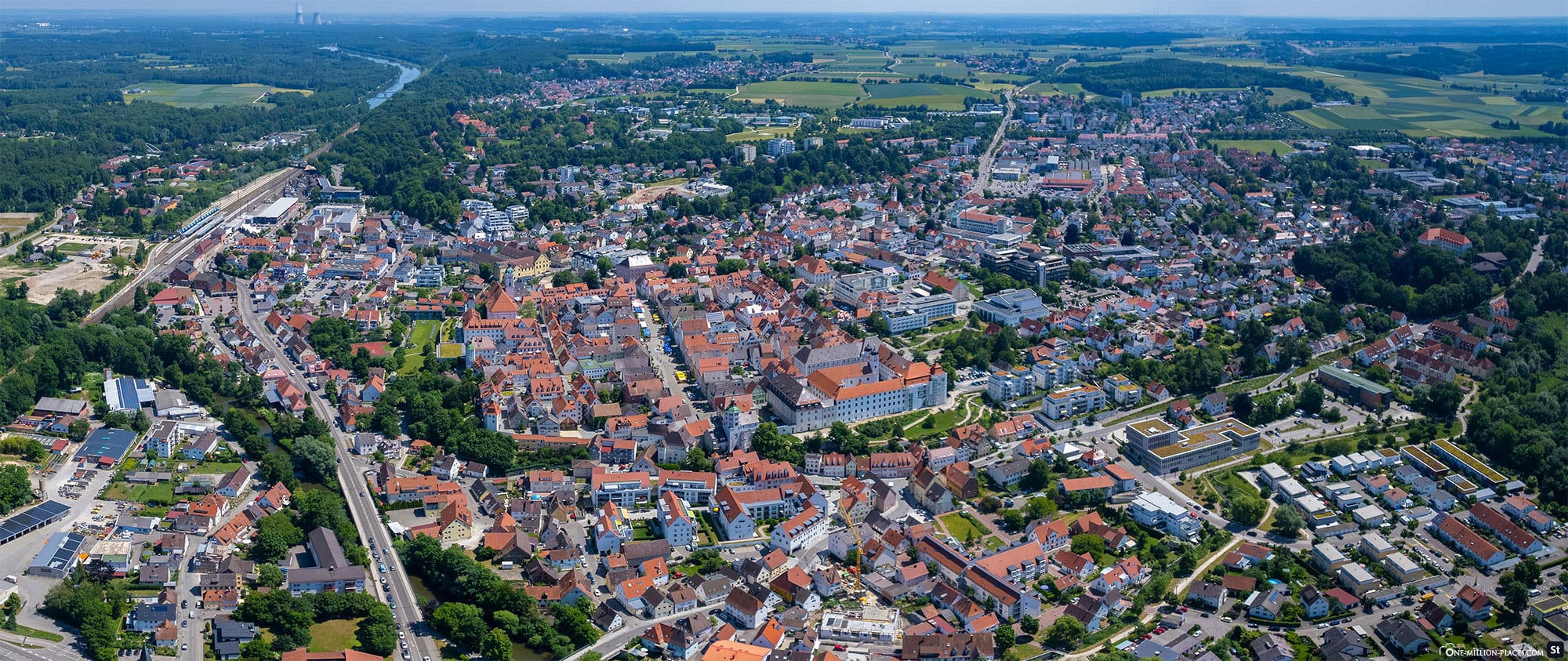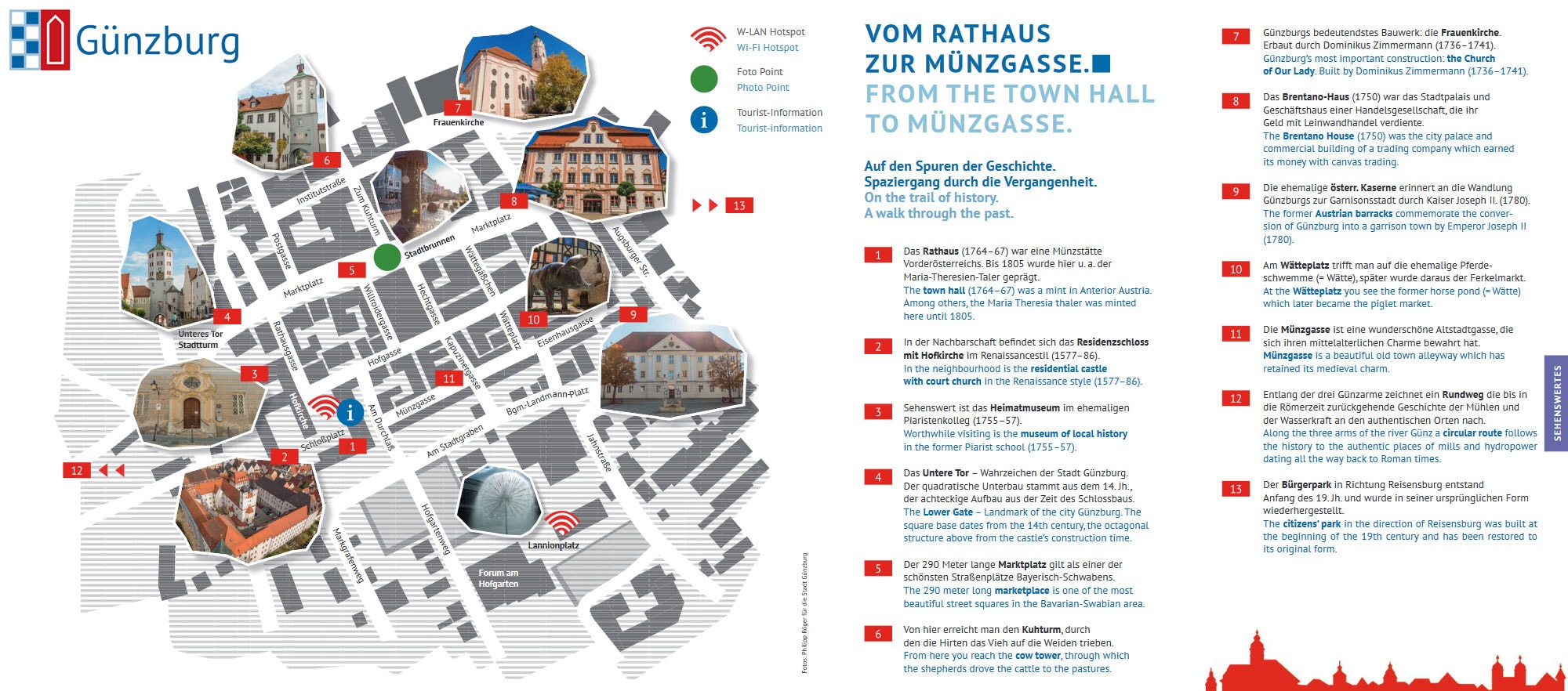The town of Günzburg is an ideal starting point for visiting the nearby LEGOLAND Deutschland theme park and the new PEPPA PIG Park. We visited the district town in the beautiful region of Bavarian Swabia and show you the most famous sights in the old town such as the Lower Gate, the castle and ‘the longest café mile in Bavarian Swabia’ as well as a few nice activities for children, such as our hike with alpacas.

Table of contents
Interesting facts about the town of Günzburg
Günzburg is located in the Swabian part of Bavaria at the confluence of the rivers Danube and Günz. This location makes the city a hub between larger cities such as Ulm and Augsburg. Günzburg also benefits from its proximity to the A8 highway, which provides quick access to Munich and Stuttgart. The scenic surroundings, which are characterized by gentle hills and dense forests, offer numerous opportunities for outdoor activities and nature experiences.
The town of Günzburg can look back on a rich and eventful history. Its origins date back to Roman times, when the settlement of Gontia was founded here. Over the centuries, Günzburg has been shaped by various rulers and dynasties and has been the scene of numerous historical events. In the Middle Ages, Günzburg developed into an important trading center and was granted town privileges in the 14th century. A striking chapter in the town’s history is its almost 500-year affiliation with Vorderösterreich until the end of the 18th century, before Günzburg fell to Bavaria in 1806.
The city on the Danube offers its 22,000 inhabitants and visitors from all over the world a wide range of sights and leisure activities. The medieval city center with its well-preserved historic buildings and narrow streets is particularly worth mentioning. The striking Günzburg Castle, built in the Baroque style, is another highlight. For families and leisure enthusiasts, the LEGOLAND Deutschland Resort and the newly opened PEPPA PIG Park are an absolute must, located in the immediate vicinity of the city. The local museum and the Frauenkirche also offer interesting insights into the culture and history of the region. Nature lovers will get their money’s worth in the surrounding forests and on the banks of the Danube, where numerous hiking and cycling trails invite you to explore.
Places of interest in Günzburg
We arrived in Günzburg at around 12 noon on a Saturday and parked in the “Am Stadtgraben” parking lot right next to the castle (location on Google Maps). From here it is only a few meters to the old town, which took us a good 4 hours to explore.
We really enjoyed the “Young explorers on the move” city rally, which we used to explore Günzburg. Children can playfully discover the history of Günzburg and have to answer various questions about numerous sights on and around the market square. The 11 questions for the city rally can be downloaded here free of charge. Once all the questions have been answered, the kids can pick up a small reward at the tourist information office on Schloßplatz 🙂
Another way to explore the city is via an eavesdropping tour. To do this, simply download the corresponding app to your cell phone free of charge and you’re ready to go. The audio guide tour“LAUSCHTOUR Günzburger Stadtrundgang – Das kleine Wien in Bayerisch-Schwaben” takes you to all the important sights in the historic center of Günzburg in German or English. Incidentally, the audio guide app includes 20 other listening tours that introduce fascinating places in Bavarian Swabia.
Map of the old town
The following map gives you a good overview of the sights in the old town of Günzburg. A detailed brochure on Günzburg can be downloaded here free of charge as a .pdf version.
Residential Palace with Court Church
In the immediate vicinity of the town hall is the residential palace with its Renaissance-style court church. The palace was built in the 16th century and is considered to be the only Habsburg residence in Germany today. Over the centuries, the castle has undergone numerous renovations and suffered damage from fires and bombs, meaning that its appearance has changed considerably over time. Today, Günzburg Residential Palace is home to the tax office and tourist information office, among other things.
Lower Gate – the city’s landmark
The Lower Gate is a striking historical building and one of Günzburg’s most important landmarks. It was originally part of the medieval town fortifications and served as the entrance gate to the town. The gate was built in the 14th century in the Gothic style, but has undergone numerous changes and renovations over the centuries: The square base dates from the 14th century and the octagonal superstructure from the time the castle was built.
Our tip: The city tower is open every Tuesday from 10 am to 2 pm. After the ascent, members of the Altstadtfreunde Günzburg e.V. serve veal sausages, pretzels and cool drinks in the Türmerstube – and there’s a wonderful view to boot.
Marketplace
Günzburg’s 290-meter-long market square is the beating heart of the historic old town and a central meeting point for residents and visitors alike. With its impressive length and the colorful houses surrounding it, the market square offers a picturesque and lively cityscape. In the summer months, the square is transformed into the longest street café in Swabia and the old town acts as an open-air stage for numerous events. One of the oldest weekly markets in the region also takes place here every Tuesday.
We really liked the fountain in the middle of the market square. Our children were able to splash around here and we were able to relax on the two red deckchairs set up by the town right next to the fountain. A really nice place to stay!
We had lunch at the Mary Lou restaurant in the Brentanohaus, a former city palace built in 1747. Here you will find ‘feel good food’, i.e. bowls, wraps, salads and much more. Everything is fresh and light, quick and tasty – and above all a real eye-catcher 🙂
Church of Our Lady
The Roman Catholic Frauenkirche is considered Günzburg’s most important building. It was built in the middle of the 18th century in the rococo style and is considered one of the masterpieces of the master builder Dominikus Zimmermann. The church impresses with its ornate façade and the richly decorated stucco work and frescoes in the interior. When we visited the church, the local gospel choir was having a rehearsal, which we were able to listen to briefly. That was really nice!
Other sights in the old town
Starting from the market square, we strolled through the alleyways of the old town and explored other sights, such as the cow tower, through which the shepherds used to drive their cattle to pasture, or the piggy fountain on Wätteplatz.
We continued on to the Dossenberger Hof. The former Austrian barracks, which were built in 1780/1781, are located here. The simple building is a reminder of Günzburg’s transformation into a garrison town by Emperor Joseph II. Today, the building houses the adult education center. Opposite the former barracks is the Iron House, which was originally the south-eastern corner tower of the town fortifications and a powder magazine. In the 18th and In the 19th century it served as a state prison with an apartment for the jailer.
We particularly liked the Münzgasse – a picturesque old town alley that has retained its medieval charm and offers great photo opportunities.
At the end of our tour, we made a short stop at the playground at the forum so that our children could run around a bit. The playground is beautifully designed with a large wooden ship with a slide, swings, climbing walls and a sandpit. A special highlight is a LEGO figure at the edge of the playground, which draws attention to the nearby LEGOLAND Deutschland Resort.
Activities in Günzburg
The town of Günzburg has a number of activities to offer. We would like to present some of them to you here.
LEGOLAND Germany
We explored LEGOLAND Deutschland on a warm summer’s day and are happy to share our impressions and experiences with you in our blog post: LEGOLAND amusement and theme park
The PEPPA PIG Park
We also spent a whole day at the PEPPA PIG theme park and are happy to tell you all about what we experienced with Peppa and her friends: PEPPA PIG Park
Hiking with alpacas in the Donaumoos
A special experience for us and our children in Günzburg was to go hiking with alpacas in the Donaumoos.
When we drove into the yard, we were greeted warmly by Jochen, the owner. After a few brief words of welcome, we walked to the alpaca stable. A total of 47 alpacas live here on the farm and we were allowed to go for a walk with two of them: At our side were the two boys Bonito and Callado. From the farm we walked through the picturesque surroundings of the Donaumoos. Jochen told us lots of interesting facts about alpacas, e.g. how to lead them, how to care for them and how they live. Bonito and Callado were super sweet, so that even our older daughter was allowed to lead an alpaca with our help without any problems. She was so proud of it and couldn’t get the grin off her face 😉
In addition to keeping alpacas, the farm also has its own farm store (every Friday from 2 to 6 pm and by appointment) with various products made from alpaca wool such as socks, ponchos, comforters, pillows, sweaters, hats, scarves and gloves.
Our tip: If you want to go hiking with alpacas in the Donaumoos, you should book an appointment early, as Jochen told us that the popular weekend dates are sometimes fully booked months in advance.
Bertelemühle organic farm
On the way back home, we made a short stop at the Bertelemühle organic farm in Günzburg. After we had parked our car, we were greeted by the farm dog wagging his tail 🙂
There was a lot going on at the organic farm, as a school class was visiting. We first looked at the various animals such as goats, pigs, donkeys and Galloways and then had a look around the farm store, which is located on the ground floor of the mill. The old beams and milling machines are still in place, giving the salesroom a special flair. Here you can get everything from meat, cheese, fruit and vegetables for everyday use and everything in 100% organic quality. Goat’s cheese, jams and baked goods are even made in-house. In the farm store we were also able to meet the owner of the farm, who gave us some information about the business. For example, she told us that she took over the farm from her grandfather Mr. Bertele in 1999 and has been running it with her husband ever since. The farm also includes a former mill, hence the farm name “Bertelemühle”.
As a parting gift, she gave us a few home-made products from her farm store, such as jam, liver sausage and goat’s cheese, which we tried at home.


